991.2: They’re all turbos now
What is it?
This is Type 991, Gen 2: the latest iteration of a car that made Porsche’s name part of the mainstream vernacular. The biggest news is its engine.
The 2017 911 Carrera starts on the 991 platform, introduced as the 2012 911, replacing the 997. Just the third all-new foundation in the 911’s 51 years, the 991 was lengthened and re-proportioned to increase interior space and move more mass forward of its rear wheels. It continues into generation two with the ’17 Carreras –updated with standard adaptive suspension, optional rear steer, a revised PDK transmission and turbocharged engines across the line, starting with the ’17 Carreras and moving forward through the dozen or so variants Porsche fashions from 991.2.
Porsche has some experience with turbos, yes. The 911 Turbo was the first series-built sports car with pressure-regulated turbocharging, and it’s evolved into the ultimate 911 and a brand unto itself. Four decades later, there are cars with turbocharged engines, and there is the Turbo.
The rationale is obvious enough, rooted in government mandates to reduce CO2 emissions and improve fuel economy. Forced induction remains the best and maybe only way to reduce displacement and continue the horsepower increases buyers expect. Even Ferrari has thrown in, and the holdouts grow fewer and further between. With 991 Gen 2, it’s Porsche’s turn.
The best news? The most fuel-efficient 911s ever are also more powerful, quicker and as agreeable as ever to drive.
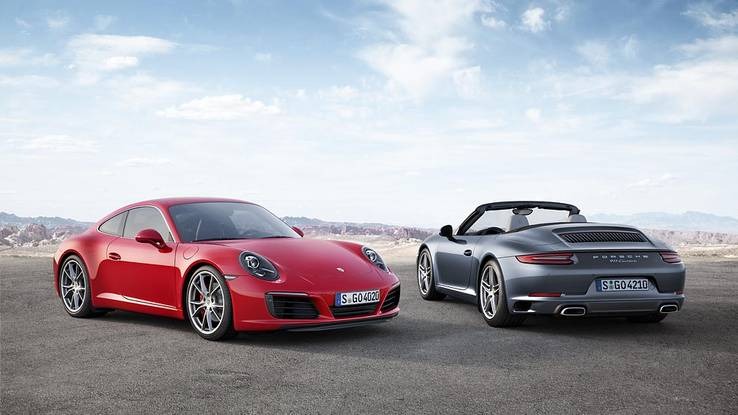
2017 Porsche 911 Carrera S and the 911 Carrera Coupe
The new turbo engine’s displacement shrinks to 3.0 liters — from the standard Carrera’s 3.4 and the Carrera S’ 3.8. Porsche’s boxer six is revised throughout, with new heads and relocated injectors, a fuel pump for each bank and still higher fuel pressure — up to 3,625 psi. Metallurgy enhancements wring 3.3 pounds from the crankcase, and Porsche’s first composite oil pan shaves off another four pounds. Efficiencies have been squeezed from nearly every component, according to Porsche. The bearings generate less friction, the accessories suck less power, lubrication has been refined and the water pump has a clutch to turn only when needed.
There’s a BorgWarner turbo for each bank with a conventional fixed impeller, rather than the more sophisticated variable geometry turbos used in the Turbo. The blowers measure 49 millimeters in diameter on the Carrera engine, 51mm on the Carrera S. The only other differences in the engines are model-specific exhaust and electronic mapping.
The new 3.0 six makes 370 hp, 332 lb-ft in the Carrera; 420 hp, 370 lb-ft in the S.
That’s a 20-hp, 45-lb-ft increase for both cars compared to 2015s with the larger naturally aspirated engines. Acceleration times are quicker by as much as 0.45 second, according to Porsche. And thanks to improvements throughout 991.2, the standard Carrera now laps the Nordschleife a hair quicker than the previous S. EPA numbers are pending, but in the EU measurement cycle the new Carrera’s fuel consumption has dropped 12 percent on average.
The standard seven-speed manual transmission uses a new, twin-disc clutch, while Porsche DoppelKupplungsgetriebe — the PDK dual-clutch automatic — gets several efficiency enhancements. The first is a dual-mass flywheel with a centrifugal pendulum, intended to reduce vibration and allow the engine to run at even lower rpm in higher gears. Ratios in the two transmissions are identical but revised from the previous generation to account for extra torque. They’re generally higher from third gear up.
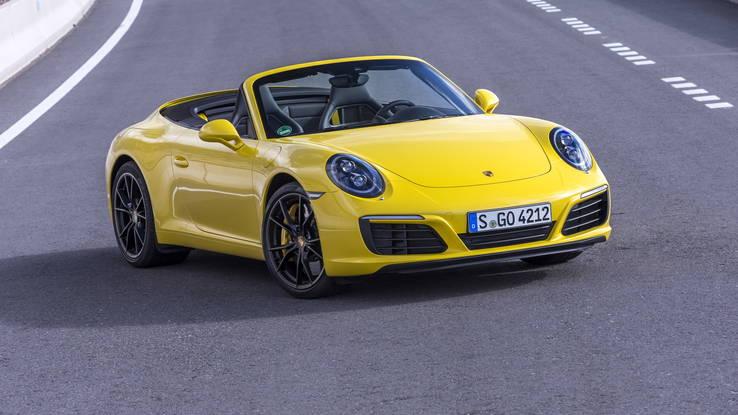
2017 Porsche 911 Carrera S Cabriolet in Racing Yellow
Airflow has been revised substantially to feed the turbos and charge coolers, and the 911 body gets a bit more aluminum to counteract extra weight in the powertrain. Porsche says weight increases are measured in tens of pounds from Gen 1 to Gen 2, despite the mass of two turbochargers, intercoolers and their plumbing.
Styling updates are subtle. They start with slightly larger grilles in the front valance (for the engine coolant radiators), fitted with louvers that open or close to balance cooling demands and aero efficiency. They end with two vents in the corners of the rear bumper to dump air flowing through charge coolers. In between are four DRL diodes fixed around the main projection headlights, reshaped mirrors, new door handles and a revised engine-cover grille.
Porsche Active Suspension Management — the brand’s electronic variable damping system — is now standard, lowering ride height about half an inch. PASM for the Carrera S (already standard) has been revised for a broader spread of dampening rates and lowers ride height another half inch. There’s an optional hydraulic lift that can raise the front end 1.6 inches for driveways or speed bumps.
Porsche’s rear-steer system, introduced on the Gen 1 GT-3 and Turbo, is now optional on the Carrera S. It replaces conventional toe-control links with electric actuators varying rear-wheel angle up to 2 degrees. The rear wheels turn in the opposite direction of the fronts at speeds up to 30 mph to decrease turning radius. They turn in the same direction over 50 mph to enhance stability during high-speed directional changes. Brakes are upgraded to account for more mass and speed, with larger rotors and 17 percent more swept area.
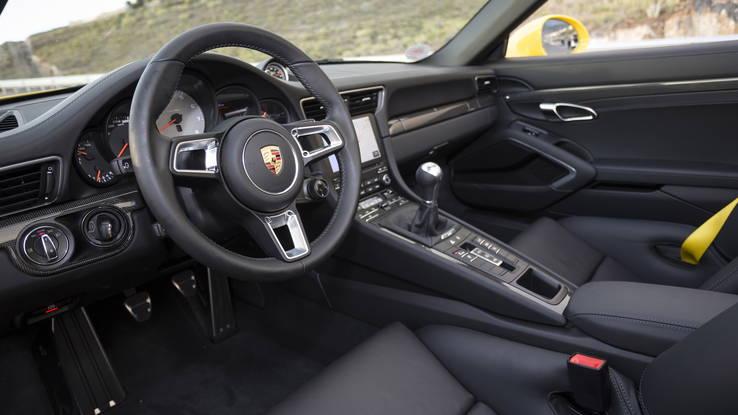
2017 Porsche 911 Carrera S Cabriolet in Racing Yellow
Inside, there’s an updated infotainment system with a multi-gesture touchscreen. Porsche’s smartphone app is available in the 911 for the first time, offering vehicle tracking and several remote operations.
You can order your 2017 Carrera now — standard or S, coupe or Cabriolet — with deliveries expected by March 2016. Base prices for all increase about $ 5,000 from 2015. Carrera 4s and Targas roll out over the next six months, while the Gen 1 911 GTS, GT-3 and Turbo will sell side by side with the Gen 2s for the next year.
Those last two 911 variants — the GT-3 and Turbo –could present the biggest quandary in the changeover to Gen 2. The GT-3 has always been sort of the anti-Turbo and might remain the only naturally aspirated 911. Since they’re now all turbos, what distinguishes the ultimate 911 with the capital T? At this point, only Porsche knows, but the turbocharged Carreras nonetheless offer an interesting perspective on four decades of 911 development.
In 1975, the original 3.0-liter 911 Turbo generated 260 bhp and required 5.5 gallons of gasoline to cover 62 miles in the EU’s combined fuel-economy cycle. The 2017 3.0-liter Carrera makes 42 percent more horsepower and travels the same distance on a hair less than 2 gallons.
Chew on that, Porschefiles.
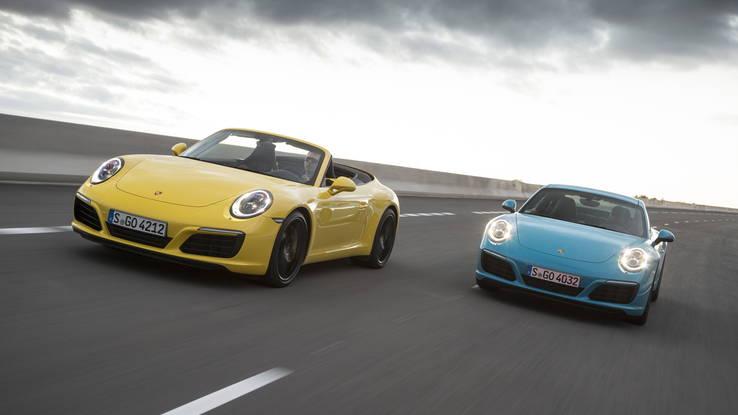
2017 Porsche 911 Carrera S Cabriolet in racing yellow and the 911 Carrera S Coupe in Miami Blue
What’s it like to drive?
A bit quicker for sure, with the pure, full-flavored goodness that built a legend and a wash-and-wear quality suited for just about any climate, locale or purpose. Presumably with better mileage. The 911 has balanced high performance, enthusiasm and good sense better, longer than any car springing to mind. Nothing about 991.2 changes that.
Inside, there’s a familiar feeling in the narrow-back, integrated-headrest buckets, but it’s nicer than it’s ever been — light years better than a 996, for example, and that car seemed like a stunning upgrade then. The finish is good enough throughout that cheapish bits like the plastic trim on the steering wheel seem to be glaring exceptions. Porsche has taken a page from Ferrari, putting a normal/sport/sport-plus dial on the steering wheel. There’s a push-to-pass button in the center, setting all electronics to full sport for 20 seconds.
Maybe because turbos have felt normal in a 911 for about 40 years, the ’17 Carrera doesn’t feel the least bit strange. There’s nothing we’d call turbo lag and nothing to diminish the Porsche boxer’s credentials as one the sweetest, most wholesomely satisfying engines extant. If anything, the range of satisfaction is broader, with more torque flowing near the low end, continued eagerness to build revs and no wheezing near the 7,500-rpm redline. A Gen 1 or 997 owner won’t find any distinction in power delivery, impressionistic impact or performance, except for the sound.
Yeah, the new Carreras sound different, but not unfamiliar. They sound like a Turbo, and aural splendor has never been a Turbo strength. To its credit, Porsche has added no digitized noise. It hasn’t gone to great lengths to disguise or manipulate the sound emanating behind the driver’s shoulders. You definitely hear the high-pitched whine of spinning turbos, particularly with the optional Sport exhaust. The primary difference from normally aspirated Carreras is the blending, muffling effect of exhaust turbocharging. It covers the flat six’s high-speed, whistling clatter with a more generic curtain of powerful sound.
The payoff? A legitimate answer probably requires ownership, or a long-term test or at least EPA ratings for some sort of baseline. We’d guesstimate a 2- to 3-mpg EPA increase, especially with PDK, and that’s nothing to scoff at.
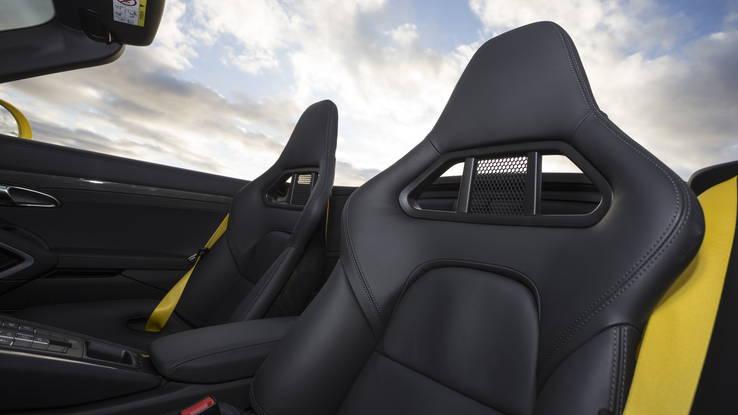
2017 Porsche 911 Carrera S Cabriolet in Racing Yellow
The new Carreras retain the oft-maligned electrically boosted steering introduced in 991 Gen 1, and after a good drive in Gen 2 we don’t really get the maligning. There are differences, maybe even shortcomings, compared to the 997. The most significant is a bit more numbness on center. Yet from there 991 steering is just fine, steadily building feedback as the front tires load. Turn-in feels as sharp as ever, with consistently accurate trajectory allowing the average hack to hit marks consistently, even when a bump wants to bounce the 911 away from an apex. Steering feel is a function of more than power assist — shaft stiffness, geometry, suspension tuning and tires — and the 911’s might be the best electric assist so far.
With standard PASM and a bit more rear tire, the new Carreras retain that trademark 911 feel — call it a dose of tail heaviness, even though there is less mass behind the rear axle than ever. Handling is vice free on the road, and there’s so much lateral grip the stability electronics are hard to find on dry pavement.
There’s impressive structural integrity and enough isolation and suspension compliance, few will rue their choice of transport on decaying urban roadways. The ride is still firm at the softest damping rate — firm enough to induce steady vibration in belly fat on full washboard surfaces — but if that’s a deal-breaker you might think about something besides a sports car. It all comes packaged in a car that has evolved well in most of the right ways.
We’re left with Carreras a bit faster and a bit grippier. They should cost less to run and generate less CO2, without significant payback, unless you consider turbo sound significant. What’s not to like must be left for the Luddites and flat-earth disciples — the sort who curse the day Porsche water-cooled the 911 or built the first
Need some flat earth? As good as PDK is (might be the best), and for all the tech and the extra bit of speed and efficiency it delivers, the manual transmission remains the way to go. It still feels most like a 911, by the sensations through the pedals and the way you feel power build, boxer style. No worries about engine or road speed –you don’t even have to shift that much if you don’t want to. The engine is so flexible, so amenable, you can cover a range of 50 mph or so in second or third gear, with decent response easily keeping with traffic flow. You can even lumber through corners with no shift.
And we can thank the good ol’ U.S. of A for that. Here where we invented the automatic and everyone buys one, the take rate for manual-transmission 911s is still easily the world’s highest. Porsche execs concede if it weren’t for demand here, or the outcry that might follow the end of the clutch pedal, 991 Gen 2 probably would not have a manual transmission at all.

2017 Porsche 911 Carrera S Coupe in Miami Blue
Do I want it?
Of course you do, fool. This car has done as much as any to shape the tastes of multiple generations of enthusiasts around the world. Despite the Chicken Littles who insisted the sky was falling when it was equipped with coil springs, the 911 has stayed as true to its original values and defining character as any car alive. That applies even with a full line of turbocharged engines.
The question is, which one you want? Do you want a Carrera now, or a C4 or a Targa, or do you wait to see what the next capital T has in store?


























